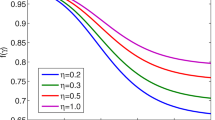Abstract
In this paper, an upper bound on the symbol error probability (SEP) of the M-ary \(\theta \)-quadrature amplitude modulation scheme, in a channel subject to additive white Gaussian noise (AWGN) and \(\eta -\mu \) fading, is calculated by means of the union bound. In addition, an exact and closed-form expression for the pairwise error probability (PEP) of the system is derived. The PEP expression obtained is written in terms of the Beta function and the Lauricella hypergeometric function. Another expression for the PEP, written in terms of the Beta function and the Appell hypergeometric function, and two bounds for the PEP, one lower and one upper, are also presented. An exact expression for the optimum rotation angle for quadrature phase shift keying constellation, considering this channel model, is also determined. In addition, an analysis, in terms of PEP, of the modulation diversity system combined with a maximum ratio combining receiver in channels subject to \(\eta -\mu \) fading and AWGN noise, is performed. PEP and SEP curves, as a function of signal-to-noise ratio, are plotted and corroborated by simulations performed with the Monte Carlo method under different parameters that characterize the channel mathematically. All the expressions determined in this article are closed and new.







Similar content being viewed by others
References
Yacoub, M. D. (2007). The \(\kappa -\mu \) and the \(\eta -\mu \) distribution. IEEE Antennas and Propagation Magazine, 49(1), 68–81.
Parsons, J. D. (2010). The mobile radio propagation channel (2nd ed., p. 436). Hoboken: Wiley.
Cheffena, M. (2012). Industrial wireless sensor networks: Channel modeling and performance evaluation. EURASIP Journal on Wireless Communications and Networking, 2012(297), 1–8.
Cheffena, M. (2016). Propagation channel characteristics of industrial wireless sensor networks. IEEE Antennas and Propagation Magazine, 58(1), 66–73.
Ahamed, I., & Vijay, M. (2017). Comparison of different diversity techniques in MIMO antennas. In Proceedings of the international conference on communication and electronics systems (ICCES) (pp. 47–50).
Mitic, D., Lebl, A., Trenkic, B., & Markov, Z. (2015). An overview and analysis of BER for three diversity techniques in wireless communication systems. Yugoslav Journal of Operations Research, 25(2), 251–269.
Lopes, W. T. A. (2003). Diversidade em modulação aplicada à transmissão de imagens em canais com desvanecimento. Ph.D. Thesis (in Portuguese), Federal University of Campina Grande (UFCG), Campina Grande, Brazil.
da Silva, C. R. C. M. (2001). Solução generalizada para técnicas de diversidade-combinação. Ph.D. Thesis (in Portuguese), University of Campinas (UNICAMP), Campinas, Brazil.
Taricco, G., & Viterbo, E. (1996). Performance of component interleaved signal sets for fading channels. Electronics Letters, 32(13), 1170–1172.
Slimane, S. B. (1998). An improved PSK scheme for fading channels. IEEE Transactions on Vehicular Technology, 47(2), 703–710.
Özyurt, S., Kucur, O., & Altunbas, I. (2007). Error performance of rotated phase shift keying modulation over fading channels. Wireless Personal Communications, 43(4), 1453–1463.
Yilmaz, A., & Kucur, O. (2011). Performance of rotated PSK modulation in Nakagami-\(m\) fading channels. Digital Signal Processing, 21(2), 296–306.
Lee, J., Yoon, D., & Cho, K. (2012). Error performance analysis of \(M\)-ary \(\theta \)-QAM. IEEE Transactions on Vehicular Technology, 61(3), 1423–1427.
Lopes, R. F., Queiroz, W. J. L., Lopes, W. T. A., & Alencar, M. S. (2013). Performance of the modulation diversity technique for \(\kappa -\mu \) fading channels. EURASIP Journal on Wireless Communications and Networking, 2013, 1–18.
Alencar, R. T., Cavalcante, M. A., Lopes, W. T. A., Queiroz, W. J. L., & Alencar, M. S. (2014). Modulation diversity effects in Rayleigh fading multipath channels. In Proceedings of the international telecommunications symposium (pp. 1–5).
Yilmaz, A., & Kucur, O. (2014). Performance analysis of modulation diversity with OSTBC transmission over Nakagami-\(m\) fading channels. AEÜ - International Journal of Electronics and Communications, 68(1), 59–63.
Özyurt, S., & Kucur, O. (2018). Performance analysis of maximal ratio combining with transmit antenna selection and signal space diversity under exponential antenna correlation. IET Communications, 12(5), 612–619.
Craig, J. W. (1991). A new, simple and exact result for calculating the probability of error for two-dimensional signal constellations. In Proceedings of the IEEE military communication conference (Vol. 2, pp. 571–575).
Leon-Garcia, A. (2008). Probability, statistics, and random process for electrical engineering (p. 833). Upper Saddle River: Prentice Hall.
Gradshteyn, I. S., & Ryzhik, I. M. (2007). Table of integrals, series and products (p. 1220). New York: Academic Express.
Silva, H. S., Alencar, M., Queiroz, W. J. L., Teixeira, D. B. A., & Madeiro, F. (2019). Bit error probability of the \(M\)-QAM scheme under \(\eta -\mu \) fading and impulsive noise in a communication system using spatial diversity. International Journal of Communication System, 32, e3959.
Acknowledgements
This study was funded in part by Coordenação de Aperfeiçoamento de Pessoal de Nível Superior (CAPES)—Finance Code 001, and by Conselho Nacional de Desenvolvimento Científico e Tecnológico (CNPq).
Author information
Authors and Affiliations
Corresponding author
Additional information
Publisher's Note
Springer Nature remains neutral with regard to jurisdictional claims in published maps and institutional affiliations.
Rights and permissions
About this article
Cite this article
Silva, H.S., Almeida, D.B.T., Queiroz, W.J.L. et al. SEP of the M-ary \(\theta \)-QAM signals under \(\eta -\mu \) fading and AWGN noise in a communication system using spatial diversity. Wireless Netw 26, 4529–4542 (2020). https://doi.org/10.1007/s11276-020-02346-8
Published:
Issue Date:
DOI: https://doi.org/10.1007/s11276-020-02346-8




